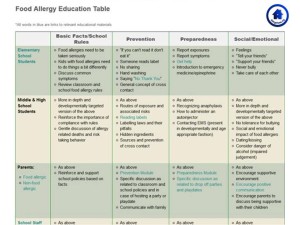Written by Michael Pistiner, MD, MMSc

This is an exciting time for food allergy and anaphylaxis awareness. We now have a comprehensive and practical set of Federal Guidelines to assist US schools in the management of food allergies. These voluntary guidelines are sure to serve as an excellent foundation for schools to implement school policies, especially useful in states without their own guidelines. Further, this resource assists schools with the heavy lifting when it comes to food allergy education and in creating safe and supportive schools for students with food allergies.
The Voluntary Guidelines for Managing Food Allergies in Schools and Early Care and Education Programs
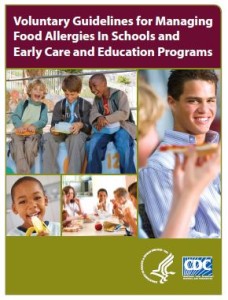 The Voluntary Guidelines for Managing Food Allergies in Schools and Early Care and Education Programs (CDC Food Allergy Guidelines) are a powerful and practical tool that will undoubtedly help guide schools in the management of food allergies. With contributions from experts and representatives experienced in school health and the management of food allergies and anaphylaxis, this guidance document serves as an excellent foundation to implement school policies. It has been written in a way that allows for variation in implementation, as schools have very different resources and cultures, as well as strengths and challenges.
The Voluntary Guidelines for Managing Food Allergies in Schools and Early Care and Education Programs (CDC Food Allergy Guidelines) are a powerful and practical tool that will undoubtedly help guide schools in the management of food allergies. With contributions from experts and representatives experienced in school health and the management of food allergies and anaphylaxis, this guidance document serves as an excellent foundation to implement school policies. It has been written in a way that allows for variation in implementation, as schools have very different resources and cultures, as well as strengths and challenges.
Of Five Priority Areas, Two Involve Food Allergy Education
The Voluntary Guidelines for Managing Food Allergies Implementing (CDC Food Allergy Guidelines) name 5 “priority areas”. These are ensuring that 1)appropriate food allergy management is implemented for the individual student, 2)schools are prepared for allergic emergencies, 3)staff gets food allergy training/professional development, 4)students and families get food allergy education and 5)educational environments are healthy and safe.
Food Allergy Education for Entire School Communities
Educating the entire school community is key to establishing communities of support for students with food allergy.
Food Allergy Awareness for Students: Bottom-Up
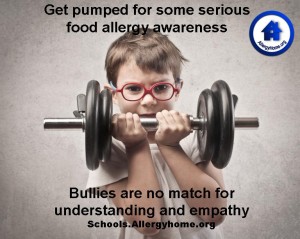 Students pick up on the messages of their teachers, parents, and others in the school community. Direct education to students can be very effective. Children also can play an important role in teaching each other, their parents, and play a critical role in establishing a supportive community. Bullying may arise when there are misconceptions and negative attitudes about food allergies. Replacing these with education can create an environment of support and understanding.
Students pick up on the messages of their teachers, parents, and others in the school community. Direct education to students can be very effective. Children also can play an important role in teaching each other, their parents, and play a critical role in establishing a supportive community. Bullying may arise when there are misconceptions and negative attitudes about food allergies. Replacing these with education can create an environment of support and understanding.
Food Allergy Awareness for All Parents
If parents understand why certain food allergy management strategies must be implemented then they can become key players to develop supportive school communities. Knowing why it is that students with a food allergy need certain accommodations is important in keeping school communities from dividing over food allergy issues. Communication and education is key for everyone, because managing food allergies can’t be the sole responsibility of the student and parents (some kids are too young to communicate their needs, and parents are not present at school or at all play dates and parties).
Staff Food Allergy Training/Professional Development
School staff food allergy education is necessary in creating communities of support. Staff can be the eyes and ears of the school nurse when it comes to emergency management of allergic reactions and are key players in food allergy management for individual students. In some states some staff may be trained to administer epinephrine when the school nurse is unavailable. Staff play key roles in establishing safe and supportive school communities for children with food allergies. Their education and understanding is absolutely critical.
Schools.AllergyHome.org created to help with implementation
In-order to help with the implementation of the CDC Food Allergy Guidelines as well as state guidelines like MA, NY, CT and others, we have voluntarily created a set of free online educational tools that are designed to help school nurses, or their designees, deliver education and awareness to their schools. These resources target school staff, all parents, and students to deliver practical easy-to-understand information that is consistent with the Federal Guidelines. Modules, posters, tables, notifications, an online handbook, a PTA tip sheet, other resources, and links to trusted educational websites are available to compliment current food allergy education being provided in school.
Food Allergy Education Modules
Each module (PowerPoint with audio) has been carefully created to keep the viewers attention, while clearly presenting practical evidence based or best practice advice. The modules were created to be versatile; applicable to large groups in the school setting or the individual from the comfort of their own home. All modules have been reviewed by food allergy experts and created to provide relevant content to the target group. Modules are freely available to educate students, parents, as well as school staff.
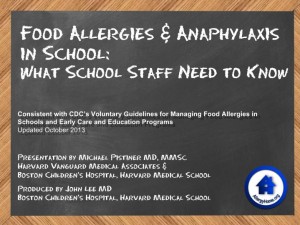 The staff training module has recently been updated to be consistent with the Voluntary Guidelines for Managing Food Allergies (CDC Food Allergy Guidelines). It has been reviewed by a team of national experts with vast experience in the management of food allergies in school. In a recent study by the Massachusetts School Nurse Research Network, the module was demonstrated to significantly increase knowledge, confidence, and positive attitude (especially concerning bullying) toward food allergies. Results were presented in abstracts at the National Association of School Nurse Annual Conference and at the New England Society of Allergy. A paper is currently in progress. This module has been used extensively throughout the US and is accompanied by a post viewing quiz and certificate of completion.
The staff training module has recently been updated to be consistent with the Voluntary Guidelines for Managing Food Allergies (CDC Food Allergy Guidelines). It has been reviewed by a team of national experts with vast experience in the management of food allergies in school. In a recent study by the Massachusetts School Nurse Research Network, the module was demonstrated to significantly increase knowledge, confidence, and positive attitude (especially concerning bullying) toward food allergies. Results were presented in abstracts at the National Association of School Nurse Annual Conference and at the New England Society of Allergy. A paper is currently in progress. This module has been used extensively throughout the US and is accompanied by a post viewing quiz and certificate of completion.
Food Allergy and Anaphylaxis Awareness Posters
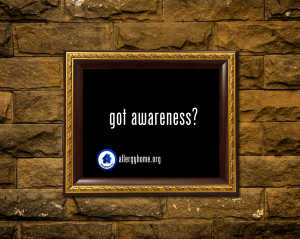 As part of an AllergyHome Food Allergy and Anaphylaxis Awareness Campaign we have used pop culture to educate and empower adolescents, young adults, and the young at heart. Using colorful and catchy food allergy and anaphylaxis awareness posters, we tackle very serious issues and put a spin on them that will hopefully engage and spark the interest of our highest risk population. There are over thirty free 8 1/2 ” x 11″ posters that schools can print out, post and distribute. They have been created to spread food allergy awareness.
As part of an AllergyHome Food Allergy and Anaphylaxis Awareness Campaign we have used pop culture to educate and empower adolescents, young adults, and the young at heart. Using colorful and catchy food allergy and anaphylaxis awareness posters, we tackle very serious issues and put a spin on them that will hopefully engage and spark the interest of our highest risk population. There are over thirty free 8 1/2 ” x 11″ posters that schools can print out, post and distribute. They have been created to spread food allergy awareness.
AllergyHome is honored to be listed as a resource in the Voluntary Guidelines for Managing Food Allergies (CDC Food Allergy Guidelines) and we hope that this tool helps schools smoothly implement the educational components of the guidelines and foster communities of support for children with food allergies.
